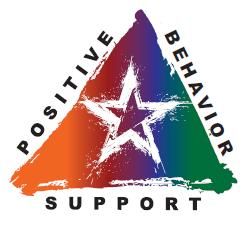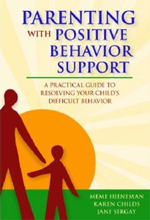
Parenting, Special Education  In the book Parenting with Positive Behavior Support, co-authors Hieneman, Childs and Sergay explain, “Positive Behavior Support involves changing things to avoid problems altogether, make difficult circumstances better, or add reminders to encourage good behavior.” Instead of reacting to problem behaviors with punishment, attention is given to teaching social skills and creating a calm, respectful learning environment.
Instead of assuming that a person knows the appropriate behavior in a situation, it is necessary to teach social expectations actively and explicitly. Visual supports such as picture schedules and cue cards are a simple way to teach expectations. Arrangement of furniture like shelves, tables and sofas can help guide a person through each stage of an activity. All of these are productive methods for prevention of negative behaviors.
In the book Parenting with Positive Behavior Support, co-authors Hieneman, Childs and Sergay explain, “Positive Behavior Support involves changing things to avoid problems altogether, make difficult circumstances better, or add reminders to encourage good behavior.” Instead of reacting to problem behaviors with punishment, attention is given to teaching social skills and creating a calm, respectful learning environment.
Instead of assuming that a person knows the appropriate behavior in a situation, it is necessary to teach social expectations actively and explicitly. Visual supports such as picture schedules and cue cards are a simple way to teach expectations. Arrangement of furniture like shelves, tables and sofas can help guide a person through each stage of an activity. All of these are productive methods for prevention of negative behaviors.
 Teaching occurs at the same time as observation and supervision. Students need a constant flow of positive interactions with an adult - it’s a way for them to get feedback about expectations and staying on the right track. Environmental triggers for negative behaviors are noted for future modification.
In the Fall 2012 issue of Autism Spectrum Quarterly, co-authors Sprick, Hinesly and Urbina outlined their approach to positive behavior support in a classroom setting. One of their strategies is to “catch students being good,” with 3 positive teacher-student interactions for every one response to misbehavior.
Negative behaviors are corrected quietly and privately with simple, non-judgmental statements such as, “Try it this way.” Positive behaviors are acknowledged with social reinforcers: eye contact, a smile, a high-five, a nod or saying the student’s name.
Overusing phrases such as “good job” may be counterproductive - I know that when my son wants to be acknowledged for something, he gets right in my face to see my eyes. And that’s enough for him. When words are necessary, specific, descriptive praise such as “I can tell that you did the assigned reading last night” or “You matched the colors very carefully” is more effective than generic comments. The most powerful reinforcers are relationship-based.
Teaching occurs at the same time as observation and supervision. Students need a constant flow of positive interactions with an adult - it’s a way for them to get feedback about expectations and staying on the right track. Environmental triggers for negative behaviors are noted for future modification.
In the Fall 2012 issue of Autism Spectrum Quarterly, co-authors Sprick, Hinesly and Urbina outlined their approach to positive behavior support in a classroom setting. One of their strategies is to “catch students being good,” with 3 positive teacher-student interactions for every one response to misbehavior.
Negative behaviors are corrected quietly and privately with simple, non-judgmental statements such as, “Try it this way.” Positive behaviors are acknowledged with social reinforcers: eye contact, a smile, a high-five, a nod or saying the student’s name.
Overusing phrases such as “good job” may be counterproductive - I know that when my son wants to be acknowledged for something, he gets right in my face to see my eyes. And that’s enough for him. When words are necessary, specific, descriptive praise such as “I can tell that you did the assigned reading last night” or “You matched the colors very carefully” is more effective than generic comments. The most powerful reinforcers are relationship-based.
What Is Positive Behavior Support? (Part One)
This is part one of a two part series on Positive Behavioral Support. Positive behavior support: that phrase got your attention, didn’t it? It sounds like a great idea, but most people don’t actually want to put in the effort for it. Unfortunately, punishment and negative attention - comments such as “Stop it!” and “No!” - seem to come more naturally to most of us. But this idea just won’t go away. So - what is it and why is it here to stay?Teaching Styles From The Olden Days
In the traditional school classroom - the type of classroom I remember from when I was growing up - there is an implicit expectation of compliant behavior, and anyone who deviates from the expected behavior is punished. When I was a kid, I noticed that the non-compliant students became more and more defiant every time they were punished. In other words, the punishment wasn’t doing what it was supposed to do.A New Environment And A New Approach
Nowadays, there is a sharp increase in the percentage of students with special needs - and many of these students have unusual behaviors that would have been punished in a traditional school environment. Behavior management has become a large and important field of study, with its own publications such as the Journal of Positive Behavior Interventions and 30 years of data consistently supporting the effectiveness of positive behavioral interventions and supports (PBIS) in thousands of schools and therapy programs around the world.What Is PBIS?
PBIS is an educational approach that can be summarized as “prevent, teach, reinforce,” a phrase coined by research teams at the University of Colorado and the University of South Florida. So how do adults prevent unsafe, destructive, disruptive or inappropriate behavior? In the book Parenting with Positive Behavior Support, co-authors Hieneman, Childs and Sergay explain, “Positive Behavior Support involves changing things to avoid problems altogether, make difficult circumstances better, or add reminders to encourage good behavior.” Instead of reacting to problem behaviors with punishment, attention is given to teaching social skills and creating a calm, respectful learning environment.
Instead of assuming that a person knows the appropriate behavior in a situation, it is necessary to teach social expectations actively and explicitly. Visual supports such as picture schedules and cue cards are a simple way to teach expectations. Arrangement of furniture like shelves, tables and sofas can help guide a person through each stage of an activity. All of these are productive methods for prevention of negative behaviors.
In the book Parenting with Positive Behavior Support, co-authors Hieneman, Childs and Sergay explain, “Positive Behavior Support involves changing things to avoid problems altogether, make difficult circumstances better, or add reminders to encourage good behavior.” Instead of reacting to problem behaviors with punishment, attention is given to teaching social skills and creating a calm, respectful learning environment.
Instead of assuming that a person knows the appropriate behavior in a situation, it is necessary to teach social expectations actively and explicitly. Visual supports such as picture schedules and cue cards are a simple way to teach expectations. Arrangement of furniture like shelves, tables and sofas can help guide a person through each stage of an activity. All of these are productive methods for prevention of negative behaviors.
Constant Interaction Needed
 Teaching occurs at the same time as observation and supervision. Students need a constant flow of positive interactions with an adult - it’s a way for them to get feedback about expectations and staying on the right track. Environmental triggers for negative behaviors are noted for future modification.
In the Fall 2012 issue of Autism Spectrum Quarterly, co-authors Sprick, Hinesly and Urbina outlined their approach to positive behavior support in a classroom setting. One of their strategies is to “catch students being good,” with 3 positive teacher-student interactions for every one response to misbehavior.
Negative behaviors are corrected quietly and privately with simple, non-judgmental statements such as, “Try it this way.” Positive behaviors are acknowledged with social reinforcers: eye contact, a smile, a high-five, a nod or saying the student’s name.
Overusing phrases such as “good job” may be counterproductive - I know that when my son wants to be acknowledged for something, he gets right in my face to see my eyes. And that’s enough for him. When words are necessary, specific, descriptive praise such as “I can tell that you did the assigned reading last night” or “You matched the colors very carefully” is more effective than generic comments. The most powerful reinforcers are relationship-based.
Teaching occurs at the same time as observation and supervision. Students need a constant flow of positive interactions with an adult - it’s a way for them to get feedback about expectations and staying on the right track. Environmental triggers for negative behaviors are noted for future modification.
In the Fall 2012 issue of Autism Spectrum Quarterly, co-authors Sprick, Hinesly and Urbina outlined their approach to positive behavior support in a classroom setting. One of their strategies is to “catch students being good,” with 3 positive teacher-student interactions for every one response to misbehavior.
Negative behaviors are corrected quietly and privately with simple, non-judgmental statements such as, “Try it this way.” Positive behaviors are acknowledged with social reinforcers: eye contact, a smile, a high-five, a nod or saying the student’s name.
Overusing phrases such as “good job” may be counterproductive - I know that when my son wants to be acknowledged for something, he gets right in my face to see my eyes. And that’s enough for him. When words are necessary, specific, descriptive praise such as “I can tell that you did the assigned reading last night” or “You matched the colors very carefully” is more effective than generic comments. The most powerful reinforcers are relationship-based.



